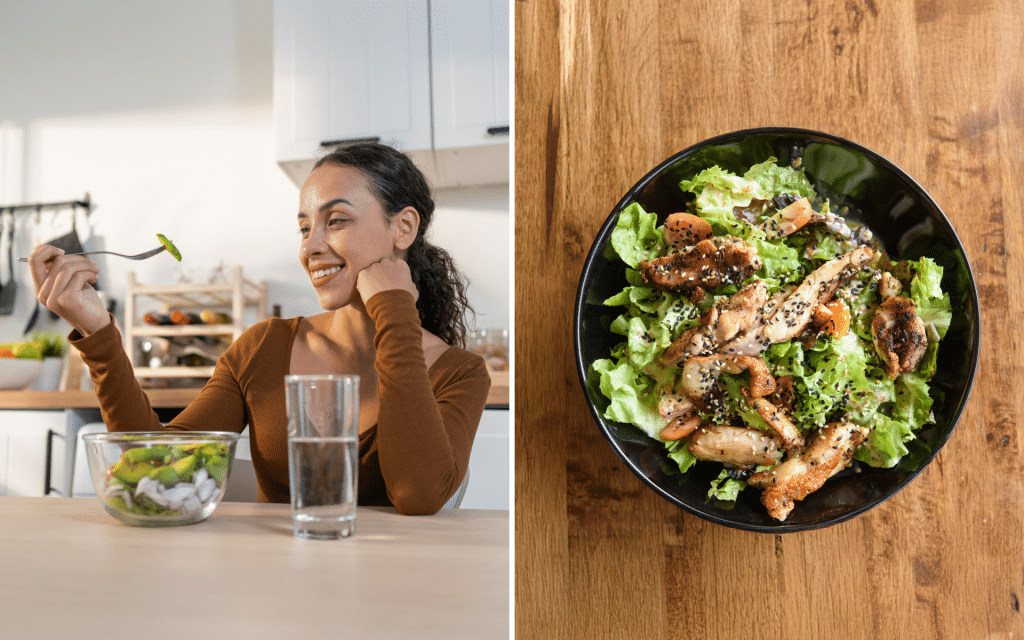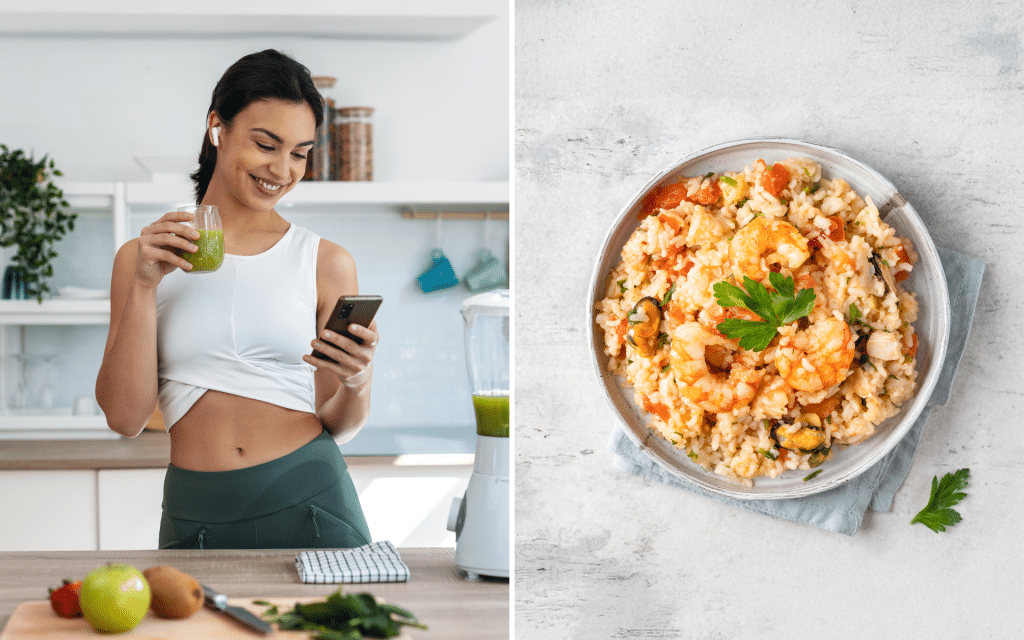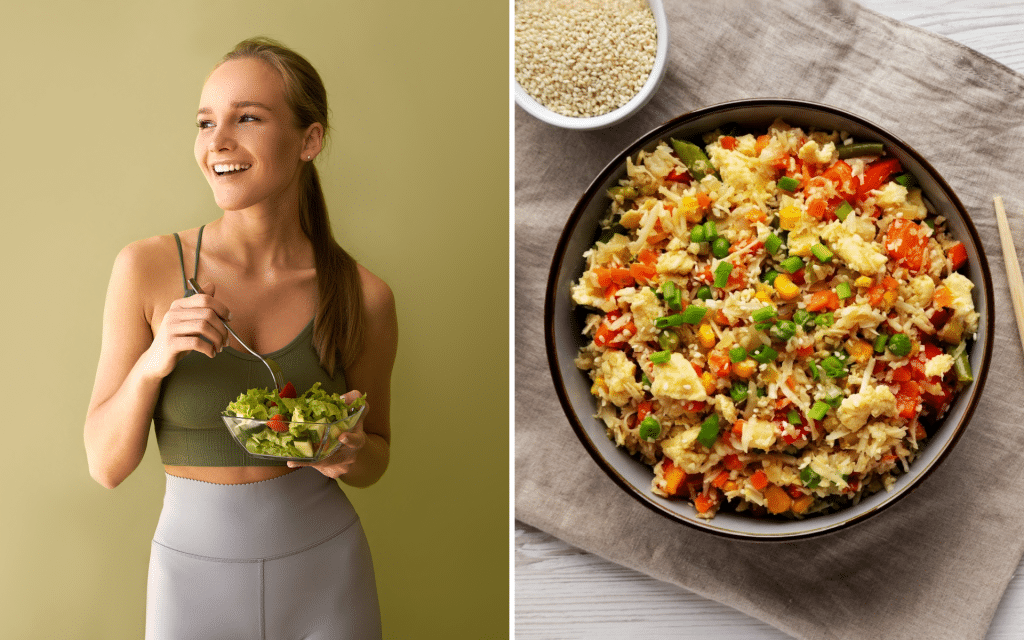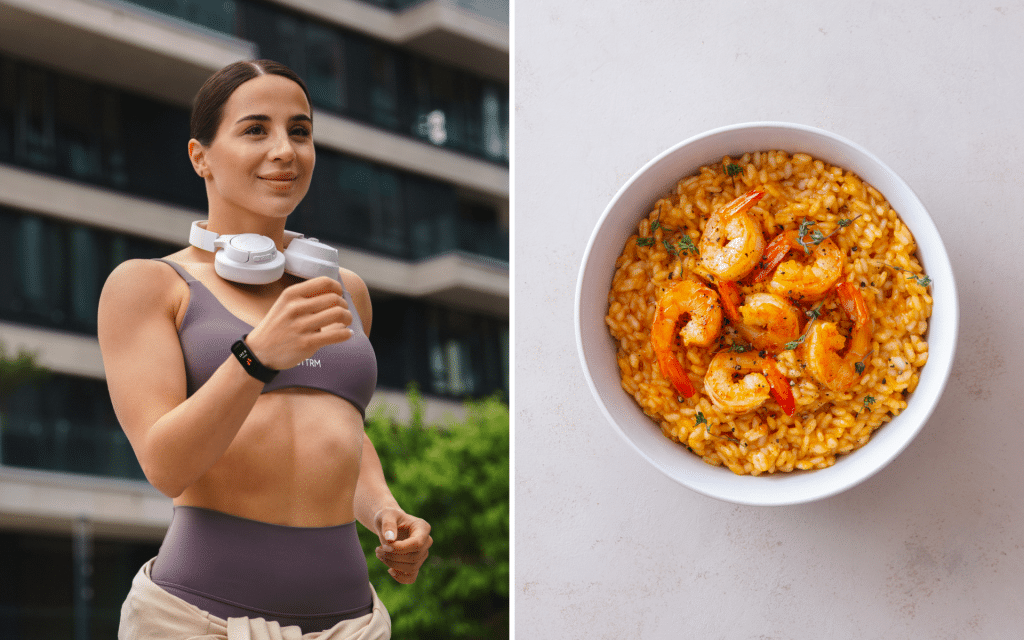Myth: Intermittent Fasting (IF) may not blend well with traditional Indian foods
After all, how do you balance sambhar, rotis, and dal with time-restricted eating?
Fact: Not only can you incorporate these beloved staples into your IF routine, but doing so can also make the experience more enjoyable and sustainable.
The principles of intermittent fasting remain the same no matter where you live or what cuisine you prefer. It’s all about when you eat, not necessarily what you eat.
But by focusing on wholesome, nutrient-dense, and balanced Indian foods, you can fuel your body effectively while sticking to your fasting schedule.
Here’s everything you need to know about combining IF with an Indian diet.
What Is An Intermittent Fasting Indian Diet Plan?
An Intermittent Fasting Diet Plan Indian-food-focused is all about blending the principles of fasting with the rich diversity of Indian cuisine. It’s not a rigid plan but a flexible framework that allows you to enjoy your favorite traditional meals while aligning with the timing structure of IF.
Intermittent fasting (IF) is an eating pattern that alternates between periods of eating and fasting. Instead of focusing on what you eat, it emphasizes when you eat.
The idea is to create a structured eating window and a fasting period, giving the body time to rest, digest, and use stored energy more efficiently (1).
Some popular forms of IF include the 16:8 method (16 hours of fasting with an 8-hour eating window daily) and the 5:2 approach (two non-consecutive days of heavily reduced calorie intake per week).
Contrary to some beliefs, you don’t have to give up your favorite Indian meals to follow intermittent fasting. However, you must be mindful of what you include in your eating window.
Traditional Indian foods like dal (lentils), roti (flatbreads), sabzi (vegetables), and rice are nutrient-dense, which makes them excellent choices for IF.
They’re rich in fiber, complex carbohydrates, and protein, helping you stay full longer and balance your energy during fasting periods (2).
Spices like turmeric, cumin, and ginger add flavor and offer health benefits like aiding digestion and reducing inflammation (3).
For an IF-friendly Indian diet, focus on food quality and balance.
Incorporating fruits, vegetables, whole grains, lean proteins, and healthy fats ensures you get the nutrients you need while keeping highly processed and sugary foods to a minimum (2).
Meals like these can work beautifully within your eating window:
- Poha with peanuts
- Grilled paneer tikka
- A wholesome khichdi with veggies
What To Eat During Intermittent Fasting In India?
Regarding intermittent fasting (IF), what you eat during your eating window is just as important as when you eat. A diet rich in balanced, nutrient-dense foods helps sustain energy, promotes satiety, and supports overall health.
1. Whole Grains
Whole grains are an excellent source of complex carbohydrates.
They break down slowly, providing steady energy that keeps you full during fasting hours (4).
Examples:
- Quinoa
- Barley
- Brown rice
- Whole wheat chapatis
- Millets like ragi and bajra
Whole grains contain fiber, which helps manage hunger and supports healthy digestion.
Fiber stabilizes blood sugar levels, reducing energy crashes between meals (5).
2. Proteins
Protein keeps you feeling full and helps repair and build body tissues.
It also plays a key role in maintaining muscle mass, particularly if you’re trying to lose weight (6).
Examples:
- Tofu
- Eggs
- Fish
- Dal (lentils)
- Chickpeas
- Kidney beans
- Lean chicken
- Paneer (cottage cheese)
Proteins take longer to digest, making them a great addition to your meals (7).
They also help prevent muscle loss during weight loss, vital for maintaining a healthy metabolism (8).
An intermittent fasting indian diet plan for weight loss must include sufficient protein.
When it comes to weight loss, progress is made by inches, not miles, so it’s much harder to track and a lot easier to give up. The BetterMe: Health Coaching app is your personal trainer, nutritionist, and support system all in one. Start using our app to stay on track and hold yourself accountable!
3. Healthy Fats
Healthy fats are a concentrated source of energy.
They also help absorb fat-soluble vitamins like A, D, E, and K, which are crucial for your body’s functions (9).
Examples:
- Olive oil
- Sesame
- Avocados
- Groundnut
- Nuts (almonds, walnuts)
- Seeds (flaxseeds, chia seeds)
- Plant-based oils like mustard, groundnut, sesame, or olive oil
Including healthy fats in moderation helps control hunger and supports heart health (9, 10). For instance, adding a teaspoon of sesame oil to your dal or using olive oil for cooking are simple ways to incorporate good fats.
4. Fruits And Vegetables
Fruits and vegetables contain many vitamins, minerals, fiber, and antioxidants.
They help fight inflammation and support overall health (11).
Examples:
- Leafy greens (spinach, fenugreek)
- Root vegetables (carrots, sweet potatoes)
- Seasonal fruits (mangoes, watermelon, oranges), and berries
Their fiber content keeps digestion in check, while their micronutrients (like potassium and magnesium) help balance electrolytes, particularly important after prolonged fasting (11).
5. Beverages
Staying hydrated during fasting and eating windows is key to feeling your best.
Choose beverages that nourish your body without adding unnecessary calories.
Examples (Fasting phase): Water, black tea, black coffee, or herbal teas (like tulsi or chamomile) – These should not have any sweetener, milk, or cream.
Examples (Eating phase): Coconut water, buttermilk, fresh lime water (with minimal or no sugar), vegetable soups, or unsweetened aam panna
Hydration supports vital body functions, including digestion, circulation, and temperature regulation (12). Some herbal teas may also soothe digestion and reduce bloating (13).
6. Snacks And Small Meals
Snacking within your eating window can be okay if done thoughtfully.
Choose nutrient-dense options that won’t spike your blood sugar.
Examples:
- Roasted chickpeas
- Makhana (fox nuts)
- Boiled peanuts
- A handful of trail mix
- A slice of multigrain toast with peanut butter
These snacks provide a balance of protein, fiber, and healthy fats.
This nutrient balance can help relieve hunger and prevent overeating during main meals.
Read more: Best Foods to Break a 3-Day Fast: What to Eat to Break a Fast
What Not To Eat During Intermittent Fasting In India?
While intermittent fasting (IF) focuses on when you eat, what you avoid eating is equally important.
The wrong food choices during your eating window can lead to:
- Hunger pangs
- Energy crashes
- Hinder your health progress
Here is a list of foods you should avoid or have in moderation:
1. Ultra Processed Foods
Highly processed foods contain unhealthy additives like added sugars, unhealthy fats, and excess sodium. These can harm your overall health in the long run if they make up too large a proportion of your diet (14).
Examples include packaged food like:
- Chips
- Instant noodles
- Frozen meals
They lack essential nutrients and are often high in empty calories, providing a lot of energy but little to no beneficial nutrients (14). They can be hyper-palatable and easy to overeat while leaving you unsatisfied.
2. Sugary Items
Sugary foods and drinks are tempting but can cause quick spikes and dips in blood sugar levels. Irregular blood sugar levels can cause low energy, tiredness, and extreme hunger soon after eating (15).
Examples are sweets like:
- Jalebi
- Chocolates
- Gulab jamun
- Regular soft drinks
Sugar adds calories but has no nutritional value. Over time, excessive sugar intake increases the risk of:
- Diabetes
- Weight gain
- Metabolic problems (16).
3. Fried Foods
Fried items can be high in unhealthy fats, which experts linked to cardiovascular health risks (17, 18)
Examples:
- Pakoras
- Samosas
- Puris
- Deep-fried snacks.
These foods are calorie-dense but tend to lack fiber and aren’t as filling as more balanced choices, making fasting periods more challenging.
4. Refined Grains
Refined grains undergo processing that strips away their fiber and nutrients, leaving behind a product that quickly converts into sugar when consumed.
Examples:
- White rice
- Maida (refined flour) items like naan, white bread, and bakery products.
They have a high glycemic index, meaning they can raise blood sugar levels quickly (19). Over time, this may lead to poor energy levels and difficulty managing weight.
5. Beverages To Avoid
Some beverages contain hidden sugars or unnecessary calories, breaking your fast or hindering your health goals. Staying mindful about what you drink is as important as what you eat.
Examples (Fasting phase):
- Soda
- Juice
- Energy drinks
- Any sweetened beverages
Examples (Eating phase):
- Alcohol
- Sweetened milkshakes
- Commercially flavored lassis
Sugary drinks lack fiber and nutrients, causing blood sugar spikes.
Alcohol, on the other hand, contributes empty calories and can interfere with nutrient absorption.
Can I Eat Rice During Intermittent Fasting?
You can eat rice during intermittent fasting, but it’s important to make mindful choices.
Rice is a source of carbohydrates, which your body uses as energy.
However, not all rice is created equal.
Brown Rice vs. White Rice
Brown rice is a better choice for IF because it is a whole grain.
Whole grains retain their fiber and nutrients, which slow digestion and help maintain stable blood sugar levels (4).
White rice, on the other hand, is a refined grain (19). Refinement removes much fiber and nutrition, leaving a high-glycemic food to digest quickly.
BetterMe: Health Coaching app helps you achieve your body goals with ease and efficiency by helping to choose proper meal plans and effective workouts. Start using our app and you will see good results in a short time.
Making Healthier Choices
- Healthier swaps: Choose brown rice, red rice, or black rice, which are nutrient-dense and provide long-lasting energy. If you choose white rice, pair it with fiber-rich vegetables, lean protein, and healthy fat, all of which can slow down the digestion of the meal.
- Use portion control. Limit your rice intake to about 1-2 small servings to keep the meal balanced. Pair it with fiber and protein-rich foods like dal or vegetables to slow digestion and avoid blood sugar spikes.
- Add spices like cumin or curry leaves while cooking for additional flavor and possible health benefits. Try this Healthy Curry Recipe to enjoy bold flavors and wholesome ingredients that make mealtime satisfying and guilt-free.
Rice isn’t off-limits during IF. The key is to choose whole grains, keep portions moderate, and balance meals with other nutrients, especially fiber and protein.
Can I Eat Dal In Intermittent Fasting?
Most food experts recommend eating dal during intermittent fasting.
Dal (lentils) is an excellent source of plant-based protein, which supports muscle health and keeps you feeling full for longer. It also offers complex carbohydrates, fiber, and essential minerals like potassium and iron.
Dal has a low glycemic index (20), which digests slowly and provides sustained energy.
This effect makes it perfect for an eating window when you want to stay fueled for hours during fasting. The fiber in dal also supports healthy digestion and gut health.
To make a healthy meal:
- Stick to homemade dal recipes over the overly rich or processed versions often seen in restaurants.
- Use minimal oils while tempering spices.
- Opt for dals like moong dal or masoor dal, which are easier to digest and work well in lighter meals.
- Pair dal with a small amount of brown rice or whole wheat chapati to make a balanced meal.
- Add vegetables like spinach or carrots to your dal for an extra nutrient boost.
Interested in more healthy options?
Our blog on Healthy Indian Food explores delicious, nutrient-packed recipes that are easy to make and perfect for every meal.
Can I Eat Chapati In Intermittent Fasting?
You can include chapati in your intermittent fasting meals if you focus on quality and portion control. Chapatis, made from whole wheat flour, are rich in complex carbohydrates and fiber.
Whole wheat chapati is preferable because it retains its fiber and nutrients, which help maintain stable energy levels. Avoid chapatis made from maida (refined flour), which lacks nutritional benefits and can spike blood sugar levels.
To make a healthy meal:
- Stick to whole wheat or multigrain flour to prepare chapatis. Multigrain flour often includes other nutrient-rich grains like ragi and bajra.
- Use minimal oil or ghee while kneading or cooking.
- Limit 1-2 chapatis per meal to balance your carbohydrate intake.
- Pair chapati with protein-rich dishes like dal, paneer, or yogurt for better satiety.
What Is The Best Intermittent Fasting Window To Lose Belly Fat?
The best intermittent fasting window for losing belly fat is one that works for you so that you can sustain it long-term.
Of course, the longer you fast, the more time your body has to use its fat stores for energy. However, longer fasts may be challenging for some individuals and may not fit into their lifestyle.
Belly fat, especially “deep visceral fat,” accumulates when we consume more calories than we need and lead sedentary lifestyles (21). It’s not just aesthetically concerning, but experts have linked belly fat to health risks like diabetes and heart disease.
To lose belly fat, one needs to focus on overall fat loss through a combination of:
- Calorie deficit
- Consistent nutrition
- Regular physical activity.
IF can be a helpful tool because it limits the time you spend eating, making it easier for some people to control their calorie intake without constantly monitoring meals.
IF may burn belly fat by:
- Encouraging controlled eating windows. These set periods reduce mindless snacking and late-night calorie intake.
- Improving insulin sensitivity. Stable insulin levels during fasting windows may help your body shift from storing fat to burning fat for energy (22).
- Promoting fat oxidation. When fasting, the body uses stored fat as fuel, which may help reduce belly fat over time (23).
It’s essential to plan your meals carefully to keep them satisfying without exceeding caloric needs.
Keep in mind:
- Overeating during the eating window can cancel out the benefits of fasting, most likely related to reducing calorie intake.
- Focus on whole, nutrient-dense foods that are lower in calories but rich in fiber, protein, and healthy fats for satiety.
- Pair IF with regular exercise, particularly strength training and cardio, to support fat loss and preserve muscle.
Read more: Fasting While Working Out: Best Strategies for Maximum Results
Popular Intermittent Fasting Windows For Belly Fat Loss
1. The 16:8 Method
This method is one of the most common in IF.
You fast for 16 hours and eat within an 8-hour window every day.
For example, you might eat from 12 PM-8 PM or 10 AM-6 PM and fast the rest of the time.
You can choose any 8-hour window that works for you.
- How It Helps: The 16-hour fasting window gives your body time to use stored fat as energy. This method is more manageable for beginners and sustainable for long-term use.
- Ideal Eating Plan: Pack your 8-hour window with balanced meals focusing on proteins, whole grains, vegetables, and healthy fats. Avoid overeating just because the window is open.
2. The 18:6 Method
The fasting window lasts 18 hours, with a 6-hour eating period.
For example, eating from 1 PM-7 PM.
- How It Helps: This slightly extended fasting period may further support fat burning for those comfortable with a stricter structure.
Some scientific studies suggest fasting beyond 12 hours might help improve how the body utilizes fat as energy.
- Ideal Eating Plan: Stick to a similar nutrient-rich meal pattern like the 16:8 method, but be cautious not to under-eat.
Striking a balance between calorie deficit and nourishment is critical.
3. Finding Your Best Window
Everyone’s body responds differently. Some thrive on a shorter eating window, while others need more flexibility. The best IF schedule is the one that fits your lifestyle.
If you fast too long and overeat during your window, it may slow your progress.
We compiled an effective Indian Diet Plan To Lose Weight In 10 Days, packed with flavorful meals and balanced nutrition to help you achieve quick, sustainable results.
Yes, you can eat a banana during your eating window. Bananas are a good source of natural sugars, fiber, and essential nutrients like potassium (24). However, portion control is key if you’re watching your calorie intake. Pair it with a protein source like yogurt or nut butter for balanced energy. Yes, you can include ghee during your eating window in moderation. Ghee is high in saturated fats, which are best limited for heart health (25). Use a small amount while preparing foods or drizzle over dal and vegetables for added flavor, but choose a plant-based oil rich in unsaturated fats for your primary cooking oil. You can eat potatoes after fasting, but focus on preparation methods. Opt for boiled, baked, or roasted potatoes instead of fried versions. Pair them with protein and fiber-rich foods like lentils and vegetables to create a balanced and satisfying meal. Yes, you can have poha during your eating window. It is a light and easily digestible dish made from flattened rice. For a healthier version, add vegetables, peanuts for protein, and spices like turmeric for an extra nutritional boost.Frequently Asked Questions
Can I eat banana during intermittent fasting?
Can I eat ghee during intermittent fasting?
Can I eat potatoes after intermittent fasting?
Can we have poha during fasting?
The Bottom Line
Intermittent fasting in India is not about restrictive diets or meal plans.
It’s an eating pattern to suit your preferences and lifestyle.
If you focus on nutrient-dense whole foods, stay hydrated, and listen to your body’s hunger cues, you can enjoy the benefits of IF while still savoring traditional Indian cuisine.
DISCLAIMER:
This article is intended for general informational purposes only and does not serve to address individual circumstances. It is not a substitute for professional advice or help and should not be relied on for making any kind of decision-making. Any action taken as a direct or indirect result of the information in this article is entirely at your own risk and is your sole responsibility.
BetterMe, its content staff, and its medical advisors accept no responsibility for inaccuracies, errors, misstatements, inconsistencies, or omissions and specifically disclaim any liability, loss or risk, personal, professional or otherwise, which may be incurred as a consequence, directly or indirectly, of the use and/or application of any content.
You should always seek the advice of your physician or other qualified health provider with any questions you may have regarding a medical condition or your specific situation. Never disregard professional medical advice or delay seeking it because of BetterMe content. If you suspect or think you may have a medical emergency, call your doctor.
SOURCES:
- Intermittent fasting (2024, healthdirect.gov.au)
- Choosing Nutrient-Dense Foods (n.d., healthysd.gov)
- Health Benefits of Culinary Herbs and Spices (2019, academic.oup.com)
- Health Benefits of Dietary Whole Grains: An Umbrella Review of Meta-analyses (2016, pmc.ncbi.nlm.nih.gov)
- The Health Benefits of Dietary Fibre (2020, pubmed.ncbi.nlm.nih.gov)
- Protein (2024, betterhealth.vic.gov.au)
- Dietary protein – its role in satiety, energetics, weight loss and health (2012, cambridge.org)
- Recent Advances in the Characterization of Skeletal Muscle and Whole-Body Protein Responses to Dietary Protein and Exercise during Negative Energy Balance (2019, sciencedirect.com)
- Eating healthy fats has many benefits (2022, uclahealth.org)
- Fats and Satiety (2010, ncbi.nlm.nih.gov)
- Health Benefits of Fruits and Vegetables (2012, sciencedirect.com)
- Narrative Review of Hydration and Selected Health Outcomes in the General Population (2019, mdpi.com)
- Integrated traditional herbal medicine in the treatment of gastrointestinal disorder: the pattern of use and the knowledge of safety among the Eastern Region Saudi population (2023, bmccomplementmedtherapies.biomedcentral.com)
- Ultra-processed food exposure and adverse health outcomes: umbrella review of epidemiological meta-analyses (2024, bmj.com)
- Short-term impact of sugar consumption on hunger and ad libitum food intake in young women (2013, nih.gov)
- A High-Sugar Diet Consumption, Metabolism and Health Impacts with a Focus on the Development of Substance Use Disorder: A Narrative Review (2022, mdpi.com)
- Trans fats—sources, health risks and alternative approach – A review (2011, springer.com)
- Fried Food Consumption and Cardiovascular Health: A Review of Current Evidence (2015, mdpi.com)
- Carbohydrates and Blood Sugar (n.d., nutritionsource.hsph.harvard.edu)
- Nutritional Value of Dal (2025, mvdiabetes.com)
- Sedentary Behaviour, Visceral Fat Accumulation and Cardiometabolic Risk in Adults: A 6-Year Longitudinal Study from the Quebec Family Study (2013,journals.plos.org)
- Effect of Intermittent Fasting Diet on Glucose and Lipid Metabolism and Insulin Resistance in Patients with Impaired Glucose and Lipid Metabolism: A Systematic Review and Meta-Analysis (2022, onlinelibrary.wiley.com)
- Intermittent Fasting Regulates Metabolic Homeostasis and Improves Cardiovascular Health (2024, springer.com)
- Bananas (n.d., nutritionsource.hsph.harvard.edu)
- Health benefits of ghee: Review of Ayurveda and modern science perspectives (2024, sciencedirect.com)















